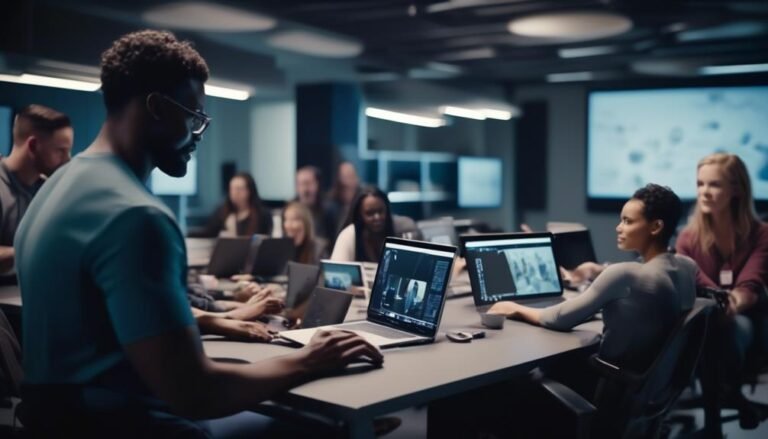Implementing Blended Learning Solutions: A Guide for HR Managers
In today's fast-paced business environment, HR managers are constantly seeking ways to enhance employee training and development. Blended learning, which combines traditional in-person instruction with online learning activities, has emerged as a promising solution.
As HR managers navigate the complexities of implementing blended learning, they face a myriad of challenges, from identifying the most suitable training methods to evaluating the effectiveness of the program.
This guide provides a comprehensive framework for HR managers to successfully navigate the implementation of blended learning solutions, addressing key considerations and best practices to ensure the seamless integration of this innovative approach into their organization's training and development initiatives.
Key Takeaways
- Blended learning combines traditional classroom instruction with online learning activities, offering flexibility, personalized learning, and increased accessibility.
- Successful implementation of blended learning requires assessing learning needs and preferences, selecting appropriate technologies, designing engaging content, integrating technology into the learning process, and ensuring high levels of employee engagement.
- Continuous evaluation and improvement are essential, including gathering feedback, analyzing data, conducting regular reviews of the curriculum, and fostering a culture of continuous improvement through knowledge-sharing sessions.
- Evaluating effectiveness involves assessing impact on employee performance and development, analyzing pre- and post-training assessments, evaluating performance metrics, using data analysis to gain insights, and measuring employee engagement.
Understanding Blended Learning
Blended learning, an innovative approach that combines traditional classroom instruction with online learning activities, has gained significant traction in the field of education and training. Its advantages include flexibility, personalized learning, and increased accessibility. However, it also comes with challenges such as the need for technological infrastructure and potential feelings of isolation among learners.
To ensure successful implementation, HR managers should consider best practices such as clearly defined learning objectives, engaging content, and regular assessments to measure progress.
Case studies have shown that organizations that effectively integrate blended learning have experienced improved learning outcomes, higher employee engagement, and cost savings. For instance, a multinational corporation implemented a blended learning program for its sales team, resulting in a 20% increase in product knowledge retention and a 15% boost in sales performance.
Understanding the advantages, disadvantages, best practices, and real-world examples of blended learning is essential for HR managers looking to implement effective training solutions. By doing so, they can leverage the benefits of blended learning while addressing its potential challenges to create a more dynamic and impactful learning experience for employees.
Identifying Training Needs
In order to create effective training programs, HR managers must first identify the specific areas where employees require development. This involves conducting a thorough training gap analysis to pinpoint the disparities between current and desired skills.
Additionally, performance assessments can provide valuable insights into individual and team needs, allowing for targeted and impactful training solutions.
Training Gap Analysis
To effectively address the needs of a diverse workforce, HR managers must conduct a thorough training gap analysis to identify the specific areas where employees require additional skills and knowledge.
This analysis involves a comprehensive skills assessment to understand the current capabilities of the workforce and to determine the development opportunities that align with the organization's goals.
By conducting a training gap analysis, HR managers can pinpoint the areas where employees lack the necessary skills and knowledge, enabling them to design targeted training programs.
This proactive approach not only helps in addressing the immediate training needs of employees but also ensures that the organization stays ahead in preparing its workforce for future challenges.
Ultimately, the training gap analysis serves as a foundational step in creating effective blended learning solutions that cater to the specific needs of the workforce.
Performance Assessment
Performance assessment is a critical process for HR managers to accurately identify the training needs of employees. By utilizing feedback mechanisms and data analysis, HR managers can gain valuable insights into employees' performance, which is essential for identifying areas that require improvement.
These assessments provide a means to measure skill mastery and determine the effectiveness of current training programs. Feedback mechanisms, such as performance reviews and 360-degree feedback, offer valuable input for understanding individual and team performance.
Data analysis allows HR managers to track progress, identify trends, and pinpoint areas for development. By leveraging these tools, HR managers can ensure that training initiatives are tailored to address specific skill gaps and contribute to overall performance improvement within the organization.
Selecting Appropriate Learning Methods
When it comes to selecting appropriate learning methods, it's crucial for HR managers to consider the various learning styles of their employees. Understanding how individuals absorb and retain information can help tailor training programs to be more effective.
Additionally, ensuring that the content is relevant to the roles and responsibilities of the employees is essential for maximizing the impact of the learning experience.
Learning Styles
How can HR managers effectively match learning methods to individuals' preferred learning styles while ensuring engagement and comprehension?
To effectively match learning methods to individuals' preferred learning styles, HR managers should consider the following:
- Visual Learning: Incorporate visual aids such as infographics, diagrams, and videos to cater to individuals who learn best through visual stimuli.
- Kinesthetic Learning: Integrate hands-on activities, simulations, and real-life scenarios to engage kinesthetic learners and enhance their understanding.
- Auditory Learning: Utilize podcasts, group discussions, and verbal instructions to support auditory learners in processing information effectively.
- Multimodal Approaches: Implement blended learning strategies that combine visual, auditory, and kinesthetic elements to cater to diverse learning styles, ensuring comprehensive engagement and learning retention.
Content Relevance
In aligning learning methods with individuals' preferred styles, HR managers must also carefully consider the relevance of the content being delivered to ensure optimal engagement and comprehension.
Content customization plays a crucial role in learner engagement and skill retention. When the curriculum is aligned with the specific needs and goals of the employees, it enhances their motivation to learn and apply the acquired knowledge.
By tailoring the content to address real-world challenges and job-related scenarios, employees are better able to see the practical applications of their learning, leading to improved skill retention.
Furthermore, incorporating interactive elements such as simulations, case studies, and practical exercises can significantly enhance the relevance of the content, making the learning experience more engaging and impactful.
Ultimately, content relevance is essential for maximizing the effectiveness of blended learning solutions.
Implementing Blended Learning Solutions
To successfully implement blended learning solutions, HR managers must carefully assess the specific needs and learning styles of their employees while considering the most effective delivery methods. This involves integrating technology into the learning process and ensuring high levels of employee engagement.
Here are four key steps for implementing blended learning solutions:
- Assessment of Learning Needs: Conduct a thorough analysis of the skills and knowledge gaps within the organization to determine the areas where blended learning can be most beneficial.
- Selection of Appropriate Learning Technologies: Choose the right mix of online platforms, learning management systems, virtual classrooms, and other digital tools that align with the learning objectives and the preferences of the workforce.
- Design of Engaging Learning Content: Develop interactive and multimedia-rich content that caters to various learning styles and preferences, ensuring that the material is engaging and relevant to the employees' roles.
- Continuous Evaluation and Improvement: Implement mechanisms to continually gather feedback, assess the effectiveness of the blended learning approach, and make necessary adjustments to optimize the learning experience.
Evaluating Effectiveness
After implementing blended learning solutions, HR managers must establish robust evaluation methods to assess the effectiveness of the learning approach and its impact on employee performance and development. Data analysis plays a crucial role in this evaluation process. By collecting and analyzing various types of data, such as pre- and post-training assessments, learning progress, and performance metrics, HR managers can gain valuable insights into the effectiveness of the blended learning program.
Moreover, evaluating the level of employee engagement with the blended learning content is essential. Surveys, feedback forms, and interactive assessments can provide HR managers with a deeper understanding of how employees are engaging with the learning materials and the overall learning experience. This information can help identify any areas for improvement and tailor the learning content to better suit the needs and preferences of the employees.
Continuous Improvement
Upon implementing a blended learning program, HR managers should prioritize continuous improvement to enhance the learning experience and maximize its impact on employee development and performance. To achieve this, HR managers can employ the following strategies:
- Feedback Loop: Establish a systematic feedback mechanism to gather input from both learners and instructors. This can be done through surveys, focus groups, or regular one-on-one discussions to understand what is working well and what needs improvement.
- Data Analysis: Utilize learning management system data to analyze the effectiveness of different learning components. This data can help identify areas where learners are excelling and where they may be struggling, allowing for targeted improvements.
- Regular Reviews: Conduct periodic reviews of the blended learning curriculum to ensure it aligns with the organization's goals and objectives. This process can help identify outdated content or gaps in the learning material.
- Sharing Best Practices: Encourage sharing of best practices among instructors and learners to foster a culture of continuous improvement. This can be achieved through regular knowledge-sharing sessions or online forums to exchange insights and successful learning strategies.
Conclusion
In conclusion, implementing blended learning solutions is a crucial aspect of human resource management.
According to a recent study by McKinsey, organizations that have successfully implemented blended learning have seen a 40% increase in employee engagement and a 30% increase in employee retention. This highlights the significant impact that blended learning can have on an organization's success.
It is essential for HR managers to understand and utilize blended learning to meet the training needs of their workforce and drive continuous improvement.







